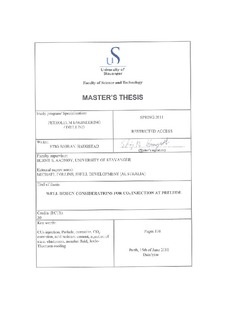| dc.description.abstract | The global economy is set to grow four-fold by 2050, promising economic benefits and a higher standard of living for millions. At the same time the global community is uniting in an effort to combat global warming. Achieving both goals will require energy to be harvested from sustainable resources. Australia, producing most of its electricity from coal, can achieve this through a switch to natural gas, in which it has a large resource base. However, most natural gas resources contain a portion CO2 which will cause large emissions. Geo-sequestration is recognized as safe mean of control and through implementation of both; a double environmental benefit can be achieved.
Prelude is a gas condensate field located in Western Australia, operated by Shell Development Australia. The field is planned to be developed as a floating LNG facility. Containing 9% CO2 it will give significant emission. The sensitivity of the emissions has prompted Shell to look at reduction measures. One such measure is re-injection into the reservoir in which the CO2 originated.
There is currently much focus on deep saline formation as these offers the largest theoretical storage potential. However, injecting into existing gas fields offer significant advantages through proven capacity and sealing structure, limiting the leak risk to wells penetrating the cap rock.
CO2 injection is not new to the industry and have been used for EOR since the 1970’s. However, injection at Prelude is more complex in two aspects:
• The pressure and temperature is much higher than the current experience with CO2 injection.
• The well is located subsea in a remote location.
To date there is only one operational subsea CO2 injector, Snøhvit, and injection generally commences at shallower depth than what is the case at Prelude. Well design at Prelude is thus pushing the envelope and it is necessary to investigate the significance.
Challenges and gaps were identified through investigating the current body of knowledge and by modelling the well through its lifecycle. Most challenges relates to the corrosive environment posed by CO2 in combination with water. If a water free system cannot be guaranteed, aggressive corrosion of carbon steel will take place, necessitating CRA’s.
The degradation of Portland cement is likely slow, being diffusion controlled. However, mechanically induced fractured can cause rapid loss of sealing capability. A more robust solution is obtained through acid resistant cements that are practically inert to CO2 attack.
Another identified area of concern was elastomers, as they are generally optimized for service with hydrocarbons. To prevent swelling, the solubility parameter of the elastomer and the fluid of which it is in contact, should be 1-2 units. With CO2 and HC having widely different parameters, this is hard to obtain. Selection of elastomers is therefore a trade-off between physical and chemical properties.
Large temperature drops were observed during operations involving pressure drops. This phenomenon is caused by Joule-Thomason cooling and observed to increase in severity with decreasing reservoir pressure. Massive temperature drops can have serious consequences but can be controlled through operational procedures.
The identified gaps are relates to modelling capabilities and measurements at the high pressure and temperatures observed at Prelude. Current modelling software lack capabilities in predicting thermodynamics of CO2 accurately, which is important for determining the loads exerted on the well and for selection of materials. Because most software are designed and developed for hydrocarbons, they lack a fit-for-purpose equation of state for CO2 mixtures with impurities. Corrosion modelling is found to be limited to 50 bar partial pressure CO2, and there is a lack of measurement data beyond this limit.
The challenges and gaps identified are not anticipated to be a showstopper for inclusion of CO2 injection at Prelude. | en_US |
